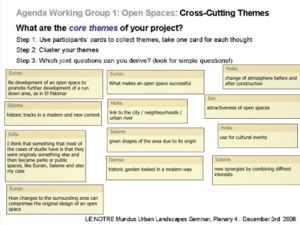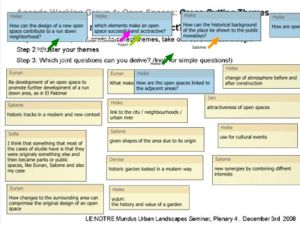First Meeting, WGs "Open Spaces" and "History and Conservation", 3rd of December 2008
Jump to navigation
Jump to search
Introduction
- Moderation: Heike
- Notes: Denise
- Participants:
- Open Spaces: Sofia, Salome, Eunan
- History and Conservation: Yujun, Denise
- others: Isin
Brief presentations of case studies
Open Spaces
- Cihampelas City Walk by Nino Christian Handoyo: skipped due to author's absence
- El Palomar by Sofia Lopez
- Landschaftspark Duisburg-Nord by Nilay Cobanoglu: skipped due to author's absence
- Lettenareal by Louis Wenger: skipped due to author's absence
- Mauerpark by Haris Piplas: skipped due to author's absence
- Naturpark Südgelände by Salome Gohl
- Parks in Neu Oerlikon by Yvonne Keller and Lars Wolfer: skipped due to authors' absence
- Petuelpark by Martina Tuda: skipped due to author's absence
- Riyadh by Christoph Dankers: skipped due to author's absence
- Smithfield Square by Eunan O'Donnell
History and Conservation
- Sulzer Industrial Area by Martina Anna Kühne: skipped due to author's absence
- Suzhou by Zhang Yujun: skipped due to technical problems
- Villa D'Este by Denise Ascione: shortened due to missing presentation
- Mosul by Ahmed: skipped due to author's absence
Identification of cross-cutting themes
Core questions identified during the first group meeting
Open Spaces
- How can the design of an open space contribute to a run down neighbourhood? [Sofia]
- How are open spaces linked to the adjacent area (e.g. neighbourhoods, city centre, river)?
- How are open spaces used (e.g. which groups meet there, which functions does an open space fulfill)?
- Which elements make an open space successful and attractive? [Eunan]
- How can the historical background of an open space be shown to the public? [Salome]
History and Conservation
- Note: The core questions for this working group will be transformed via email.
Back to Working Group Open Spaces or Working Group History and Conservation

